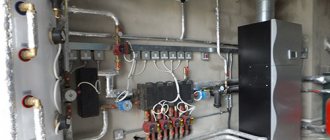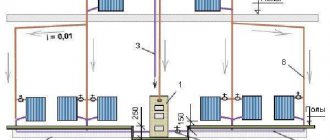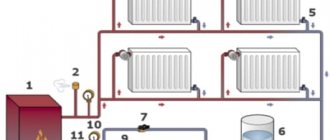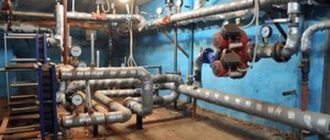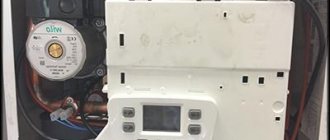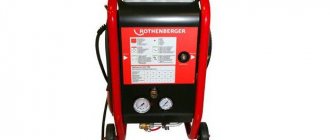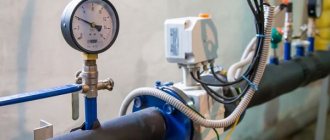Connection options
Currently there are two main connection schemes:
- dependent - considered the simplest, therefore most often used;
- independent - gained popularity relatively recently; it is widely used in the construction of new residential areas.
Below we will look at each method in more detail to find out which solution will be the most effective for ensuring comfort and coziness in your room.
Dependent connection method
This connection option usually requires the creation of in-house heating stations, often equipped with elevators. In their mixing unit, superheated water from the external main network is mixed with the return water, which allows it to be reduced to the required temperature, usually below 100 °C. Thanks to this, the heating system inside the house is completely dependent on external heat supply.
| Advantages | The main feature of the scheme is that water enters the heating and water supply system directly from the heating main, so the costs in this case pay off in a short time:
|
| Flaws | As in any scheme, here you can find not only positive aspects, but also negative ones, among which it should be noted:
|
Connection methods:
- direct connection
; - with elevator
; - with on the jumper
; - with mounting of a pump on the supply or return
; - combined option - elevator and pump
.
Independent connection method
Experts say that this heat supply option makes it possible to reduce resource costs by almost 40%.
In today's situation with their constant rise in price, this will significantly save money in the family budget.
- The operating principle is as follows:
- connection of the heating system of subscribers is made using an additional heat exchanger;
- heating occurs thanks to two hydraulic isolated circuits - the main heating main heats the coolant of the closed internal heating network;
- in this case, no mixing of water occurs.
- The coolant circulates in the heating mechanism due to a circulation pump, which regularly supplies it through the heating elements. An independent connection scheme may provide an expansion tank with a supply of water in case of leaks. In this case, it is possible to maintain the circulation of the coolant with a certain amount of heat even in the event of a heating main failure. In fact, this means that if the supply of hot water through the heating main stops, the temperature in the heated rooms will not drop sharply for a long time.
- The scope of application of this connection method is quite wide. For example, it is used:
There is one condition - the pressure in the return must be more than 0.6 MPa.
- Advantages of the method:
- the instructions allow you to adjust the temperature;
- great energy saving effect.
- Flaws:
- high price;
- complexity of repair and maintenance work.
Comparison of schemes
- The dependent option has one important advantage - low implementation cost. An elevator unit in a small country house is easily assembled with your own hands from shut-off valves, which can be purchased in a store or on the market. The only expensive part will be the nozzle, on which the power of the elevator depends.
- An independent scheme allows you to:
- adjust the coolant temperature;
- increase the efficiency of use, bringing this level to 40%;
- Large amounts of contaminants, such as scale, sand and mineral salts, do not enter the heating system. The coolant can be purified water or antifreeze liquids.
- You can easily heat clean drinking water for hot water needs.
Independent
An independent heat supply system allows you to save consumed resources by 10-40%.
Operating principle
The consumer heating system is connected using an additional heat exchanger. Thus, heating is carried out by two hydraulically isolated circuits. The external heating circuit heats the water of the closed internal heating network. In this case, mixing of water, as in the dependent version, does not occur.
However, such a connection requires considerable costs for both maintenance and repair work.
Water circulation
The movement of the coolant is carried out in the heating mechanism thanks to circulation pumps, due to which there is a regular supply of water through the heating devices. An independent connection circuit may have an expansion vessel containing a supply of water in case of leaks.
This connection method allows you to maintain the circulation of water with a certain amount of heat in case of heating main failures. Those. During an emergency, the temperature in heated rooms will not decrease.
Components of an independent system.
Scope of application
Widely used to connect multi-storey buildings or structures to the heating system, which require an increased level of reliability of the heating mechanism.
For facilities that have premises where access to outside service personnel is undesirable. Provided that the pressure in return heating systems or heating networks is higher than the permissible level - more than 0.6 MPa.
Advantages
- possibility of temperature adjustment;
- high energy saving effect;
- possibility of using any coolants.
Negative points
- high price;
- difficulty of maintenance and repair.
Comparison of reliability and durability
The practice of operating technically complex and multi-level systems shows that they are less maintainable and more often must be subject to preventive inspections with maintenance measures. It cannot be said that independent connection of the heating system reduces the overall level of reliability and safety (in some cases it even increases it), but the tactics for carrying out repair and restoration activities should be at a different and more responsible level.
At a minimum, an increase in labor and time resources will be required when inspecting the heat exchanger and adjacent piping. Possible uncontrolled accidents at this site can lead to damage to the pipeline. Therefore, experts recommend installing several sensors that monitor pressure, temperature and tightness. The latest manifold cabinets also provide for the use of self-diagnostic systems for continuous monitoring of the system condition. As for the closed heating infrastructure, such control and measuring equipment will also not be superfluous, but in this case its need is not so high.
Mercedes-benz A-class. Independent heating system
Important safety instructions
CAREFULLY
The independent heating system and exhaust gas outlet are located in front of the right front wheel.
Note
Regularly switch on the independent heating system once a month for about ten minutes.
Depending on the outside temperature, the pre-selection function of the independent heating system calculates the switch-on time in order to warm up the car by the time of departure. When the departure time is reached, the independent heating system continues heating for another five minutes and then switches off.
The independent heating system heats the air inside the vehicle to a set temperature, regardless of the waste heat from the running engine. The independent heating system runs on fuel coming directly from the vehicle's fuel tank. Therefore, for normal operation of the independent heating system, the fuel tank must be filled at least to .
An independent heating or ventilation system automatically adapts to changes in outside temperature and weather conditions. Therefore, it is possible to switch the system from ventilation mode to heating mode and from heating mode to ventilation mode.
The independent heating system switches off when the engine is switched off. The independent ventilation system is switched off when the key is turned to the more detailed
.
The independent heating system switches off automatically after 50 minutes.
The independent ventilation system does not cool the air in the vehicle below the outside temperature.
Before turning on
Turn the ignition key to the Read more
.
Set the required temperature.
Switching on an independent heating or ventilation system is also possible when manually adjusting the air conditioning system. When setting the automatic mode, an optimal microclimate in the cabin is achieved. Set the temperature to 22.
The independent heating system or the independent ventilation system can be switched on or off using the buttons on the center console or via the remote control.
Using the on-board computer, you can set up to three departure times and pre-select one of them more details
.
Switching the independent heating/ventilation system on or off using the button on the center console
General instructions
The colors of the indicator lights on the button have the following meaning:
- Blue: independent ventilation system is on
- Red: independent heating system on
- Yellow: pre-selected departure time read more
Turning on or off an independent heating or ventilation system
Click the button.
- The red or blue indicator lamp on the button lights up or goes out.
Mercedes-benz A-class. Switching the independent heating/ventilation system on or off using a remote control
General instructions
The vehicle is supplied with one remote control device. It is possible to equip the vehicle with two additional remote control devices. For further information, contact a qualified specialist workshop.
Store the independent heating system remote control so that the independent heating system cannot be switched on unintentionally. Make sure that the remote control device for the independent heating system is kept out of the reach of children.
The range of the remote control is approximately 300 m. The range decreases:
- due to exposure to sources of radio interference,
- if there are massive obstacles between the remote control device and the vehicle,
- if the position of the remote control device in relation to the vehicle is incorrect,
- when transmitting a signal from enclosed spaces.
If the remote control battery is weak, the empty battery symbol will appear on the left of the display. Replace the remote control battery and follow the important safety instructions when replacing the battery. Read more
.
Turning on or off an independent heating or ventilation system
Remote control device
| Checking status |
| Setting departure time |
| Switching off the independent heating system or independent ventilation system |
| Setting departure time |
Power on: Press and hold the button.
- The remote control display shows ON.
Power off: Press and hold the button.
- The remote control display shows OFF.
Mercedes-benz A-class. Checking the condition of the independent heating system or independent ventilation system
Briefly press the button.
The following types of display indications are possible:
| Indication | Meaning |
| The independent heating system or the independent ventilation system is switched off. | |
| The independent ventilation system is turned on. The number on the display shows the remaining operating time (in minutes) of the independent ventilation system. | |
| The independent heating system is switched on. The number on the display shows the remaining operating time (in minutes) of the independent heating system. | |
| Check-out time has been activated. The clock on the display shows the departure time. | |
| Check-out time has been activated. The independent ventilation system is currently activated. The number on the display shows the remaining operating time (in minutes) of the independent ventilation system. If after this time the car engine is not started, the operating time is extended by five minutes. | |
| Check-out time has been activated. The independent ventilation system is currently activated. The number on the display shows the remaining operating time (in minutes) of the independent heating system. If after this time the car engine is not started, the operating time is extended by five minutes. |
If the engine has not yet reached its operating temperature after starting, the operating time of the independent heating system is extended. The independent heating system continues to operate until the engine reaches operating temperature. In this case, the symbol will appear on the remote control display and the operating time will be zero minutes.
Mercedes-benz A-class. Setting departure time
Before setting the departure time, make sure that the time in the vehicle is set correctly (see the electronic Operator's Manual). Otherwise, the independent heating system may turn on at the wrong time and possibly in the wrong parking area. When setting your departure time, please observe important safety instructions. Read more
.
Briefly press the button.
Press the or button until the time to be changed appears on the display.
Press the and buttons at the same time.
- The symbol on the display of the remote control flashes.
Use the or buttons to set the required departure time.
Information
The longer you press the or button, the faster the displayed time changes.
Press the and buttons at the same time.
- The new departure time has been entered into memory.
Activating a set departure time
Briefly press the button.
Press the or button until the required departure time appears on the display.
Click the button.
- The display shows the symbol, the departure time and, depending on the selected departure time, the letter A, B or C.
Deactivating a set departure time
Briefly press the button.
- The display shows the status of the independent heating system.
Click the button.
- The first stored departure time appears on the display.
Click the button.
- The remote control display shows OFF.
content .. 31 32 35 ..
Pros of independent systems
Already at the approach to the main consumers of the home water supply network, a whole range of preparatory measures is provided to ensure distribution, filtration and adjustment of coolant pressure. All loads fall not on the final equipment, but on the heat exchanger with a hydraulic tank, which directly receive resources from the main source. Such resource preparation is practically impossible on a private basis when operating dependent heating systems. Connecting an independent circuit also allows you to rationally use water for drinking needs for optimal purification. Streams are divided according to their intended purpose and each line can provide a separate level of preparation that meets technological requirements.
Pros and cons of electric heating in the house
Electric heating can be different, from the equipment to the heating method.
There are two types of electric heating:
- With intermediate coolant.
- With direct heat output.
In the first option, an electric boiler is installed, which heats the coolant and then distributes it through pipelines.
The second type is a heating device or element that operates from the mains. Infrared heaters, convectors, heat fans, etc. are often used to heat a house. If we consider this option from a technical point of view, it is much more convenient. The main disadvantage is the high energy consumption.
Don’t forget about the convenient heating system in a private home – heated floors.
The advantage of electric heating is its high efficiency. In addition, there are many more advantages:
- Long service life.
- Low costs for purchasing, installing and connecting equipment.
- Easy to operate and maintain.
- There is no need to obtain documents to permit the installation of electrical equipment.
- System security.
- No noise during operation.
- By installing a thermostat, you can save on monthly costs.
Despite all the advantages, it is worth remembering that there will be a large load on the network, since not only an electric heating device is used, but also other household appliances. Therefore, it is recommended to install an electrical distribution device in the house.
Electrical wiring in the house must withstand heavy loads, especially in winter. To save money, it is recommended to install a multi-tariff meter, which will allow you to heat the house at night, when the electricity tariff is several times lower.
Independent heating system
A fundamental feature of this system is the presence of an intermediate collection point. In private residential buildings, it can be implemented as a regulating station (including for reducing pressure), but the integration of a heat exchanger makes this scheme independent. It performs the functions of rational and balanced redistribution of hot flows, also maintaining, if necessary, optimal temperature conditions. That is, with an independent connection of the heating system, the heating network as such does not act as a direct source of supply, but only directs flows to an intermediate technological point. Then, in accordance with the settings made, in a more targeted version, it can supply both drinking water and hot water for heating and other household needs.
Independent heat supply scheme
An independent heating circuit looks like this:
- From the supply pipeline, the liquid enters the return line, simultaneously transferring thermal energy to the heat exchanger. In this case, water is not used for hot water supply and space heating;
- the same heat exchanger, but its other circuit, receives drinking water from the water supply. After heating, it is supplied to the heating system and for domestic use.
This is what an independent heating system connection looks like.
Which heating scheme is better?
There is another drawback with gas non-volatile heating boilers - they do not have the ability to control the weather and control the unit using an external thermostat, which determines the temperature regime, for example, in the most remote room. Accordingly, it is not possible to program the temperature for a long period, for example, two weeks.
About the types of heating systems in detail in the video:
In apartment buildings, the overwhelming majority use the central heating network for heating. However, the quality of such services depends on many factors, including the condition of the heating main and equipment. The connection diagram of the house to the heating network is also important. In this case, you will learn about dependent and independent connection methods, as well as how to make heating in an apartment energy-independent.
What types of heating systems are there?
- With natural circulation, in which it is necessary to take into account the slope of the surface. Not tied to power supply.
- With artificial (forced) circulation, in which this tilt is not necessary. Depends on power supply. This system is more economical and has the possibility of self-regulation.
We can conclude that economical, comfortable autonomous heating of your home directly depends on the type of boiler, the quality and cost of the heating system itself, as well as a properly installed heating system. We guarantee competent and quick completion of all work on autonomous heating of the house, assistance in completing all documents and purchasing the necessary equipment. Replacement for our customers
and
equipment repairs
will be carried out free of charge in the future.
Dependent heating system
The central link of such communications is the elevator unit, through which the tasks of regulating the coolant are performed. From the heating main to the distribution unit of a residential building, water is supplied through a pipeline, and mechanical control is carried out by a system of inlet gates and valves - standard plumbing fittings. At the next level there are locking mechanisms that regulate the supply of hot water to the return and input circuits. Moreover, the heating system in a private country house may include two connections - for the return line and the supply channel. Next, after the home taps, there is a chamber in which the coolants are mixed. Hot streams can indirectly contact water in the return circuit, transferring some of the heat to it. Summarizing this part, we can conclude that water is sent to the hot water supply system directly from the central heating main.
Heating boilers used
One of the most popular types of boilers is pyrolysis, which operates in two steps. At the first stage, the fuel is heated at the moment of oxygen supply before the gas formation process. At the next stage, the corresponding combustion of wood occurs.
Solid fuel boiler
To prevent the reverse movement of gas, care should be taken to purchase and install an electric fan. Top-burning equipment can operate for about five days in case of a one-time supply of coal.
A regular fan promotes constant air circulation in the system.
If we are considering boilers for an independent heating system, then they are equipped with a piezoelectric element, which allows ignition without the use of other energy sources. When the fuel ignites, you can manually change the intensity of the flame. The burner is extinguished at sufficiently high raw material temperatures, and the pilot burner operates in normal mode with a uniform release of thermal energy.
The non-volatile heating system starts working after the fuel has completely cooled to the set temperature. Electricity is needed to run the fan, which supplies air.
Automatic fuel supply to the boiler
So how do you decide which is better? If your home is located far from a power line, or the electricity supply is unstable, it is better to choose the option of independent heating. A non-volatile boiler runs on gas without connecting to electricity. This heating option is economical; it allows you to reduce costs by 20% . You also get a system that allows you to manually regulate the flow of heat supplied and fuel consumption.
To prevent the house from cooling down if the heating is turned off, we recommend doing the following. The boiler is connected to a UPS with a high-capacity battery. You can also purchase a boiler that runs on diesel fuel.
For more information about boilers, watch the video:
Terminology
Let's clear up the confusion first.
Energy independence
- this is the ability of heating equipment to operate in the absence of electricity. The ability is undoubtedly pleasant, but we are not talking about it now. However, we will also touch on this topic.
What is the difference between independent and dependent heating systems? Connection diagram to the heating main.
Dependent circuit
Imagine an ordinary residential building. How is it built?
- Input valves cut off the elevator from the route.
- Behind them, on the supply and return lines, there are valves or valves embedded through which hot water can be supplied from the supply or return pipeline.
- After the hot water supply inserts, we see the elevator itself - a nozzle with a mixing chamber. A stream of hotter, high-pressure water from the direct pipeline heats up part of the return water and draws it into recirculation.
- Finally, house valves cut off the heating system. They are closed in summer and open in winter.
The key feature of a dependent heating scheme is that water enters the heating and water supply systems directly from the heating main.
Independent circuit
Now let's imagine another diagram:
- Water from the supply pipeline enters the return pipeline, giving energy to the heat exchanger along the way. Water, we repeat, is not used for heating and hot water needs.
- Drinking water from the water supply is supplied to the same heat exchanger, but to a different circuit. It heats up and enters the heating system. It can also be used for household needs.
Actually, we have comprehensively described the independent connection scheme for the heating system.
Dependent heat supply scheme
If you imagine the elevator unit of a residential building (you can see what it looks like in the photo), then it is arranged as follows:
- the elevator is separated from the heating main by inlet valves;
- behind them, at the supply and return points, valves or gate valves are located. Hot water supply is connected through them from the supply or return pipelines. Often in modern elevators there are two taps on the supply and return lines, which are separated by a retaining washer. Their purpose is to ensure constant circulation of hot water;
- after inserting the elements to provide DHW, there is a nozzle with a chamber where mixing is carried out. The flow of hotter liquid coming from the direct pipeline under high pressure heats up part of the water in the return and is sent for recirculation;
- house valves shut off the heating system of the building - they are open in winter and closed in the warm season.
Dependent and independent heating systems differ in that in the first version, water enters the hot water supply and heating systems directly from the heating main.
Comparison of solutions
The dependent heating connection scheme has, in essence, only one advantage, but a very important one - low cost of implementation. You can assemble an elevator unit for a small cottage with your own hands from consumer-grade shut-off valves
The only thing noticeable against the background of wiring batteries around the house will be the cost of manufacturing the nozzle - the only exclusive one made, the diameter of which determines the thermal power of the elevator.
What are the assets of an independent scheme?
Incomparably more flexible temperature control. It is enough just to reduce the flow of coolant through the heat exchanger - and the house will become colder.
- The practical consequence of flexible adjustment of heating to the needs of the home is efficiency.
Relative to the dependent system, it is estimated at 10-40 percent. - Finally, the main thing: in a dependent system we are forced to use water with a lot of pollution.
It carries sand, scale and a lot of mineral salts.
There is no talk of using water as drinking water; moreover, in some regions it is undesirable to even wash with hot tap water. An independent circuit makes it possible to use purified water or even non-freezing coolants as a coolant.
It is not a problem to heat drinking water for DHW needs.
Electricity addiction
Now let's return to energy dependence. When does a heating system need electricity to function, and when can it be done without?
Solid fuel boilers
The canonical solution is a conventional steel or cast iron boiler with a water jacket in the firebox and mechanical adjustment of the blower using a thermostat. This unit is completely energy independent.
The photo shows a classic solid fuel boiler.
However, this design has an important drawback: the boiler requires frequent loading of fuel. Three technical solutions allow you to make heating as independent from humans as possible:
- A hopper and a conveyor belt
supply new portions of sawdust or pellets as the fuel burns out. Electricity is required at a minimum for the transporter to operate. - divides combustion into two stages: pyrolysis of wood with a limited supply of oxygen and combustion of the resulting gas. In this case, the gas combustion chamber is located below the pyrolysis chamber. The movement of combustion products against the vector of natural draft requires the operation of an electric fan.
- An upper combustion boiler
can operate on one load of coal for up to five days. Only the top layer of fuel smolders; air is supplied to it from top to bottom, and the ash is carried away by a stream of hot combustion products. Air circulation is provided by... that's right, an electric fan.
Gas
Non-volatile gas heating boilers use manual ignition using a piezoelectric element and flame regulation by a mechanical thermostat. When the main burner is extinguished at a high coolant temperature, the pilot burner continues to operate.
Boilers with electronic ignition stop the gas supply completely when idle. As soon as the coolant cools below the critical temperature, the discharge ignites the main burner and heating resumes. In addition, electricity often drives a blower fan that supplies air to the burner.
Which scheme is better? If you have frequent power outages, a non-volatile gas heating boiler would be more appropriate. Precisely because he is able to do without electricity in principle. On the other hand, these devices are less economical: up to 20% of the total gas consumed is spent maintaining the pilot flame.
Another useful feature that gas-independent heating boilers lack is the ability to control the weather and control it using an external thermostat, which takes the temperature, for example, in a remote room. Of course, we are also not talking about programming the temperature for a day or a week.
Solara
Everything is simple here: solar boilers are COMPLETELY identical to gas boilers with electronic ignition. Only the burners differ. In fact, a lot of dual-fuel units are being produced.
It is clear that without a forced-air fan and electronic ignition, the devices simply will not be able to work.
Is it possible to make an independent system out of a dependent system?
The transition to independent heating is possible with special permission from utility services.
The dependent circuit can be converted into an independent system with the implementation of heat supply using several technological methods:
- Bunker and conveyor belt for solid fuel boiler. When fuel materials burn out, new portions enter the furnace on a transport belt. It is powered from the mains.
- Pyrolysis boiler. Combustion takes place in two stages. At the first stage, firewood is pyrolyzed with a minimum supply of oxygen, at the second stage the residual gas is burned. An electric fan is used to create thrust.
- Equipment with top combustion. Due to the smoldering of the top layer, the device operates for 5 days on one load of fuel. Air masses are pumped by an electric fan.
The optimal option for energy independence is a gas boiler with manual ignition and an adjustable thermostat for the flame.
In a dependent scheme, water enters the system through an elevator and is mixed with the return masses. An independent system eliminates this process - heating occurs through a heat exchanger. Heat supply can work in conjunction with electricity or autonomously. It is necessary to select the connection method according to the heating area and the type of object.
Safety and efficiency of independent heating systems
To be able to save money on heating, several conditions must be met:
- Develop and approve the project with the permitting authorities. Without an approved GIP and a project agreed upon with all authorities, all modifications will be illegal. Therefore, you will not be able to use the results.
- Install or reconstruct existing equipment according to the design solution.
- Install a heat energy meter. This will allow you to pay for the received thermal energy exactly in the volume in which it was consumed.
- Provide the necessary level of automation or manual regulation. CHP plants do not respond particularly quickly to temperature changes in weather conditions and can continue to fire their boilers to the fullest. And through the heat exchange tank, unclaimed energy will be transferred to the networks of consumers who open windows and vents from excess heat.
Installation and connection of an independent heating system
Installation work is not much more complex than a gravity route. Among the additional measures, it is worth noting the need to organize an uninterruptible power supply. This will make it possible not to be left without heat during a power outage and is implemented by automatically turning on a battery-powered uninterruptible power supply or a liquid fuel electric generator.
In addition, existing centralized routes are also subject to modernization by separating coolants with a heat exchange tank, installing a forced circulation pump and an uninterruptible power supply. Replacement or dismantling of pipelines with radiators is not required.
There are two types of schemes by which heating devices are connected. Depending on the use of the circuit, two types of heat supply systems are distinguished - dependent and heat supply.
The meaning of an independent heat supply system is that the subscriber's equipment is isolated from the heat supplier using hydraulics. And in order to provide subscribers with heat, auxiliary exchangers of central heating points are needed.
In the case of using a dependent system, it is necessary to constantly connect it to the energy carrier. Such a system consists of pipes and a boiler, which are interconnected into one whole. The meaning of a dependent heat supply system is to circulate hot water in a circle in a continuous mode. Due to the fact that the dependent system is completely tied to the heating main, which is the main source of thermal energy, when using it it is impossible to adjust the water temperature or even, in case of warming, turn off the heating.
Diagram of a dependent heating system
When using an independent heating system, different types of fuel can be used. It should be noted that installing such a system is quite expensive. Unlike a dependent system, in an independent system water can be used for other needs. Another advantage is that the independent one is much easier to install in a building.
Among other things, such a system makes it possible to save money due to the fact that its operation requires a small amount of fuel. The amount of fuel can be adjusted at will, thereby creating comfortable conditions in the premises.
Diagram of an independent heating system
Principle of operation
As noted above, for the operation of the dependent system, process water is used, which during operation leaves salts and sand in the pipes, which disrupts the permeability of water in the pipes. In the case of independent, it is possible to use purified. In this case, the equipment can be shown to have a fairly long service life.
An independent heating system can do without electricity. It may only be needed if a bunker and conveyor are installed in order to supply fuel to the boiler.
You can also use a boiler operating with. Such boilers are a structure consisting of mechanical, thermostat, and steel tanks. Such a system does not tie you to the gas main.
Dependent and independent heat supply scheme - housing and communal services portal.rf
Dependent and independent heat supply systems differ in the way they are connected and have fundamental differences. In future publications we will dwell in more detail on their differences and offer detailed, schematic calculations. Now we will present to you only the basic, conceptual definitions of the differences between the systems.
Dependent heat supply systems
In dependent heat supply systems there are no intermediate heat exchangers or heating points. These are systems in which the coolant enters directly into the consumer’s heating system. The main advantage of such systems is its simplicity from a design point of view. The main disadvantage of a dependent heat supply system is the extremely low efficiency of the system. The great difficulty in adjusting the temperature of the coolant during sudden temperature changes in the weather leads to overheating or underheating of the premises (decreased comfort), as well as to excessive consumption of consumed energy resources.
The use of this system in construction has now been abandoned.
Independent heating systems
The transition from a dependent heat supply system to an independent one allows you to save consumed resources by 10-40% per year. Independent heat supply systems are systems in which the heating system of consumers is separated from the heat producer through the use of hydraulically isolated circuits. Heat exchangers of various designs (tubular, plate, etc.) are used as hydraulic circuit insulators. This is a classic heat supply scheme using central heating points and is currently most widespread in the construction of new microdistricts. CONCLUSIONS:
An independent heat supply system has the following important advantages compared to a dependent one, these are 1. The ability to accurately regulate the amount of heat supplied to the consumer (by regulating the temperature of the coolant in the consumer circuit);
comment: in this case, it becomes possible to adjust the coolant temperature depending on the outside air temperature, which in turn allows you to achieve a stable, comfortable indoor air temperature (20-22 degrees C) under any sudden temperature or weather changes.
2. High reliability of the system is ensured through an integrated approach to the design of the heat supply system of a populated area and is ensured by loopback systems with the possibility of emergency switching of consumers from various heat supply sources.
comment: the importance of the concept of reliability of heat supply systems is currently acquiring the greatest relevance (remember the case of defrosting heating systems of residential buildings in the village of Tomilino, Moscow region)
3. Obtaining an energy-saving effect (heat savings of 10-40%) is achieved through the use of modern, electronic coolant temperature regulators, circulation pumps with adjustable rotation speed, metering devices for consumed thermal energy, etc.
— a set of measures to increase energy saving systems;4. The ability to use coolants with different chemical compositions makes it possible to improve the performance of the system as a whole, increasing the protection of boiler installations. 5. The possibility of effectively organizing a heat supply system at a significant distance and territorial dispersion of consumers and many others... Currently, independent heat supply systems have all the advantages of modern heat supply systems and are most often used in the design and construction of modern settlements. Despite serious financial costs and investments, the transition to independent heat supply systems is happening everywhere. _________________________________
Dependent heating system
A dependent system is often called an open system. And it is called that because a heat carrier is taken from the supply pipe to provide the house with hot water. The dependent circuit is often used in administrative, multi-apartment and other buildings that are intended for public use. The peculiarity of an open system is that the coolant flows through the main networks and enters directly into the house.
If the temperature of the coolant in the supply pipeline is no more than 95°C, then it can be sent to heating devices. But if the temperature exceeds 95°C, then it is necessary to install an elevator unit at the entrance to the house. With its help, water that comes from heating radiators is mixed into the hot coolant to lower its temperature.
Previously, no one paid special attention to coolant flow, so this scheme was often used. Dependent heating system does not require large installation costs
There is no need to lay additional pipes to provide your home with hot water.
But in addition to the above advantages, we can also highlight the disadvantages of a dependent heating system:
- Regulating the temperature in rooms is problematic. Valves quickly fail due to poor quality of the coolant.
- From the main pipes, various dirt and rust enter the heating radiators. Steel and cast iron radiators continue to operate without any changes. But in aluminum batteries, the ingress of rust and dirt has a detrimental effect on operation.
- Although the coolant undergoes all the required desalting and cleaning, it still passes through rusty main pipelines. Accordingly, the coolant cannot be of good quality. This factor is a big disadvantage, since the coolant is used for water supply.
- Due to repair work, pressure drops in the system or even water hammer often occur. Such problems can seriously affect the performance of modern heating radiators.
Energy dependence of the heating system
Energy dependence refers to the ability of heating to operate in the absence of power supply. Energy independence may be needed in cases where there is a danger of frequent and prolonged power outages. You can, of course, install emergency power supply in your home: an electric generator or batteries with an inverter. The automation will start emergency power supply immediately after the loss of power in the network. But equipment costs money and not everyone is ready to spend the money. How to ensure energy independence of heating?
Firstly, to provide energy-independent heat generation. Finding a solid fuel boiler that does not require an electrical connection is not a problem. But the vast majority of pellet, liquid fuel and especially gas boilers are equipped with automation, which does not work without power supply. However, you can find models with simpler controls. But you need to understand that you should not expect special efficiency and high comfort from a non-volatile gas boiler.
Gas non-volatile heating boilers are equipped with simple controls. Piezoelectric ignition, the specified level of coolant temperature is maintained
Secondly, to ensure effective circulation of the coolant. The movement of liquid through pipes and heating devices can be carried out naturally (gravitational) or forced (circulation). Let's briefly explain these concepts:
Gravity (non-energy independent) heating
The movement of liquid in a gravitational system occurs due to differences in the densities of the heated and already cooled liquid. The hot coolant leaving the boiler has a lower density and volumetric weight than the coolant that has already passed through the pipes and batteries and cooled down. Accordingly, heated water constantly rises, while cooled water sinks down. As long as there is a sufficient temperature difference, the coolant circulates. For normal operation of the gravitational system, a number of strict conditions must be met:
- The heating boiler must be installed at the lowest part of the system. Preferably in a pit if heating appliances are located on the same floor.
- All horizontal pipes must have a slope in the direction of flow of the coolant.
- The diameter of the pipes must be large enough to reduce hydraulic resistance. For an individual residential building this is approximately 35-50 mm.
The advantages of gravity heating include simplicity of design and energy independence. “Gravity” has a lot of disadvantages:
- Difficult to adjust, low efficiency.
- The natural pressure of the liquid is low, so the rate of passage of the coolant in the pipes is low, which is why the heating is very “thoughtful”, reluctant to warm up and does not quickly respond to changes in the operating mode of the boiler.
- The longer the pipelines, the weaker the circulation and the worse the heating of remote radiators. Horizontal branches over 30 m in length will not work properly at all.
- A low fluid flow rate corresponds to low heat transfer; the dimensions of heating devices have to be increased.
- It is impossible to install heated floors in a non-volatile gravity system; the choice of heating devices is limited to standard radiators.
- Thick distribution pipes that are difficult to hide do not look aesthetically pleasing.
Gravity heating is relatively simple in design, but it is necessary to strictly observe the necessary slopes along the flow of the coolant
Circulation (energy-dependent) heating
In a circulation system, the movement of the coolant is controlled by a circulation pump. The pump creates sufficient pressure to eliminate all the limitations associated with overcoming hydraulic resistance characteristic of gravity heating. The circulation system is completely devoid of the disadvantages of gravity. It uses small-diameter pipes without taking into account slopes, which makes them easy to hide in grooves or screeds. There are no restrictions on the height of the boiler; the expansion tank can be placed in the boiler room. In addition to wall-mounted radiators, heated floors, floor convectors are available; you can additionally heat air for supply and exhaust ventilation and water in the pool. The forced movement of the coolant makes it possible, with proper design and configuration, to constantly maintain the set temperature in all rooms. The heating heats up quickly and is sensitive to changes in the heating mode.
The circulation system is more economical, comfortable and aesthetically pleasing than the gravity system. Its only significant drawback is its energy dependence. In our opinion, the numerous advantages of the “circulation” system clearly outweigh its only disadvantage, and when choosing a heating system for a modern comfortable home, preference should be given to it. And you can insure against power outages by installing a generator or battery.
Example of circulation heating, pipe slopes are not particularly important
The gravity system also has the right to life in a country house or in a country house, which does not have high demands on interior aesthetics, comfort and heating efficiency. More logical is the combination of natural circulation with a solid fuel boiler. A rational solution is to install a circulation pump in parallel on the supply pipe of the gravity system. This will allow the heating to be operated in two modes: if electricity is available, it will work as circulation, more economically and comfortably. No electricity - operates in gravity mode. Less efficient, but it works.
A circulation pump is built into the gravity circuit, where all requirements for slopes and pipe diameters are met, so that the coolant can circulate both by gravity and by force
Dependent open heat supply system
The main feature of the dependent system is that the coolant flowing through the main networks directly enters the house. It is called open because coolant is taken from the supply pipeline to provide the house with hot water. Most often, this scheme is used when connecting multi-apartment residential buildings, administrative and other public buildings to heating networks. The operation of the dependent heating system circuit is shown in the figure:
When the temperature of the coolant in the supply pipeline is up to 95 ºС, it can be sent directly to the heating devices. If the temperature is higher and reaches 105 ºС, then a mixing elevator unit is installed at the entrance to the house, whose task is to mix the water coming from the radiators into the hot coolant in order to lower its temperature.
The scheme was very popular during the Soviet era, when few people were concerned about energy consumption. The fact is that the dependent connection with elevator mixing units works quite reliably and requires practically no supervision, and installation work and material costs are quite cheap. Again, there is no need to lay additional pipes to supply hot water to houses when it can be successfully taken from the heating main.
But this is where the positive aspects of the dependent scheme end. And there are many more negative ones:
- dirt, scale and rust from the main pipelines safely enter all consumer batteries. Old cast-iron radiators and steel convectors didn’t care about these little things, but modern aluminum and other heating devices definitely don’t;
- Due to a decrease in water intake, repair work and other reasons, a pressure drop in the dependent heating system, or even water hammer, often occurs. This has implications for modern batteries and polymer pipelines;
- The quality of the coolant leaves much to be desired, but it goes directly to the water supply. And, although the water in the boiler room goes through all stages of purification and desalting, kilometers of old rusty mains make themselves felt;
- Regulating the temperature in rooms is not easy. Even full-bore thermostatic valves quickly fail due to poor quality coolant.
Schemes for connecting heating systems to heating networks
Normal operation of the elevator occurs at H/h = 8-12 (H is the available pressure at the inlet; h is the resistance of the heating system).
It should be borne in mind that the value of the design pressure in front of the elevator is directly proportional to the resistance of the heating system. Therefore, an increase in the resistance of the heating system, for example, by 1.5 times will cause an increase in the design pressure R by also 1.5 times.
Connection with pump on jumper (c). In the event that water mixing cannot be accomplished using an elevator, install a pump on the jumper between the supply and return pipelines of the heating system. Mixing using an elevator cannot be performed for the following reasons: the pressure at the connection point is insufficient for its normal operation; the required thermal power of the mixing unit is large and goes beyond the power of manufactured elevators (usually more than 0.8 MW - 0.7 Gcal/h).
When installing mixing pumps in residential and public buildings, it is recommended to use silent, foundationless pumps. When installing mixing pumps designed for large flows, centrifugal type K and KM are used as mixing pumps. The pump flow is equal to G2 = 1.1G1, and the pressure should be equal to H = 1.15h (where h is the resistance of the heating system).
Connection to the pump on the heating system supply pipe (d). A pump is installed on the supply pipeline if, along with mixing water, it is necessary to increase the pressure in the supply pipeline at the connection point of the heating system (the static height of the heating system is higher than the pressure in the supply pipeline at the connection point).
The pump flow is equal to G3 = 1.1 (1 + U)G1, and the pressure should be equal to:
Hus=1.15h+hn
where h is the resistance of the heating system; hn is the difference between the static height of the heating system and the piezometric height in the supply pipeline of the heating network at the connection point, m.
Connection to the pump on the return pipe of the heating system (e). A pump is installed in the return pipeline if, along with mixing water, it is necessary to reduce the pressure in the return pipeline at the connection point of the heating system (the pressure is greater than permissible for the heating system). The pump flow in this case is equal to C3 = 1.1 (1 + U)G1 and the pressure must have a value that provides the required pressure in the return pipeline.
Independent accession (e). If the pressure in the return pipeline in the heating network is higher than the permissible pressure for the heating system, and the building has a significant height or is located at a high place in relation to adjacent buildings, then the heating system is connected according to an independent circuit.
According to an independent scheme, it is allowed to connect buildings with a height of 12 floors or more. The independent scheme is based on separating the heating system from the heating network using a heat exchanger; as a result, the pressure in the heating network cannot be transferred to the coolant of the heating system. Coolant circulation is carried out using circulation pumps type K and KM. The pump flow is determined by the formula
G=Q/C(T11-T22)
where Q is the power of the heating system, kJ/h (Gcal/h); C is the heat capacity of water, J/(kg h); T11, T22 - design water temperature in the supply and return pipelines of the heating system, respectively, °C
The required pump pressure should be equal to N = 1DM (psh k—resistance of the heating system). When choosing a pressure, you should strive for a minimum margin in flow and pressure. Otherwise, due to increased water flow in the heating system (speed higher than permissible), noise occurs. An independent heating system is usually equipped with an expansion vessel. Water leaks from the heating system are replenished from the network automatically based on the water level in the expansion tank.
